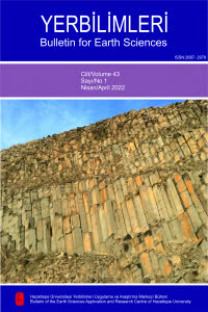Uzak alan P dalga şekillerinin sonlu-fay ters çözümünden 22 Mayıs 1971 Bingöl depremi kırılma sürecinin incelenmesi
22 May›s, 1971 Bingöl depremi Do¤u Anadolu Fay Zonu’nun (DAFZ) Bingöl ile Karl›ova aras›nda yer alan kuzeydo¤u ucunu k›rm›flt›r. Önceki çal›flmalarda, DAFZ’nun yaklafl›k 75 km uzunlu¤undaki bu kesimi Karl›ova-Bingöl Fay Parças› (KFP) ad›nda tek bir fay parças› olarak tan›mlanm›flt›r. Bu çal›flmada bir do¤rusal sonlu-fay ters çözüm tekni¤i kullan›larak, uzak alan P dalga flekillerinden 1971 Bingöl depremi için sonlu-fay kayma modeli belirlenmeye çal›fl›lm›flt›r. Uzak alan veriler; mevcut olan WWSSN (World Wide Standardized Seismograph Network)istasyonlar›n›n uzun-periyod analog kay›tlar›ndan say›sallaflt›r›larak elde edilmifltir. Depremin iliflkili oldu¤u k›r›lma alan› K51o D do¤rultulu, 82o KB’ya e¤imli, (84 x 24) km boyutlar›ndaki bir dikdörtgen yüzey ile temsil edilmifltir. Ters çözüm sonucunda elde edilen kayma modeli depremin iki fay pürüzünün k›r›lmas› sonucu meydana geldi¤ine ve gözlenmifl dalga flekillerinden de aç›kça anlafl›ld›¤› gibi, k›r›lman›n ço¤unlukla KD’ya do¤ru oldu¤una iflaret etmektedir. Deprem, fay modelinin GB yar›s›nda yerleflmifl 60 cm civar›nda kayma genli¤ine sahip büyük bir fay pürüzünün k›r›lmas› ile bafllam›flt›r. Gözlenmifl yüzey k›r›¤›yla uyuflan bu fay pürüzü (35 x 12) km boyutlar›nda bir faylanma alan›n› örtmektedir. Küçük olan fay pürüzü 40 cm civar›ndaki kayma genli¤iyle fay modelinin KD yar›s›nda yerleflmifl olup, (20 x 12) km boyutlar›nda bir faylanma alan›n› örtmektedir. Kayma modeli için hesaplanan sismik moment ve k›r›lma süresi s›ras›yla 1.1x1026 dyne.cm (MW=6.7) ve 28 s’dir. Bu bilgiler ve ayr›nt›l› fay haritalar›ndan sa¤lanan bilgiler ›fl›¤›nda DAFZ’nun Bingöl ile Karl›ova aras›nda kalan kesiminin birden fazla fay parças›ndan olufltu¤u düflünülmektedir.
Investigation of rupture history of the May 22, 1971, Bingöl earthquake obtained from the finite-fault inversion of the teleseismic P waveforms
The 22 May 1971 Bingöl earthquake ruptured the northernmost section of the East Anatolian Fault Zone (EAFZ), extending from Bingöl to the northeast of Karl›ova. This section of the EAFZ was defined as a single fault segment, namely the Karl›ova-Bingöl segment, in the earlier studies and has a length of about 75 km. In this study, teleseismic P waveforms of the 1971 Bingöl earthquake were used to obtain a finite-fault coseismic slip model using a linear finite-fault inversion technique. The teleseismic data were digitized from available analogue long-period recordings of Worldwide Standardized Seismograph Network (WWSSN) stations. The earthquake’s rupture area is represented with an 84 km by 24 km fault, striking N51oE and dipping 82o to the NW. The coseismic slip model resulted from the inversion indicated that the earthquake was associated with rupturing of two slip patches and the rupture was mostly unilateral toward northeast, which is also explicit from the data. The earthquake was initiated with the failure of the larger slip patch, located to the SW half of the fault model with slip amplitude of about 60 cm. This slip patch covers a faulting area of 35 km by 12 km, fitting the observed surface ruptures. The smaller slip patch is located to the NE half of the fault model with slip amplitude of about 40 cm and covers a faulting area of20 km by 12 km. A seismic moment of 1.1x1026 dyne.cm (MW=6.7) and rupture process time of 28 sec are computed for the slip model. This information as well as the information coming from the detailed fault maps led us to speculate on the further segmentation of the EAFZ between Bingöl and Karl›ova.
